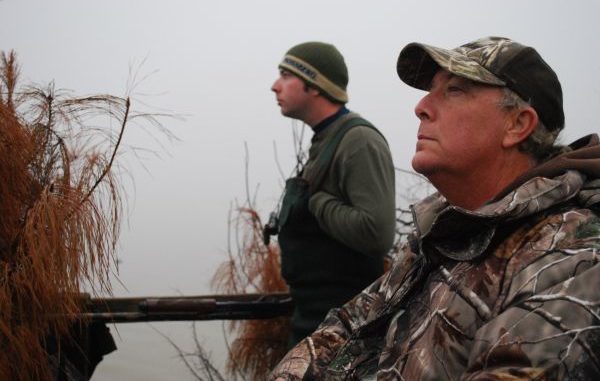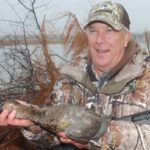
Catahoula Lake is hallowed ground in the duck-hunting world, and no one knew that better than the late Chuck Buckley. Take a walk through those grounds in his shadow.
It was a hypnotizingly peaceful afternoon. I shuffled along the banks of Little River, head down, searching intently for a pottery shard, an arrowhead — anything that the area’s first inhabitants might have left behind.
The sun’s rays felt good on my back, but the air still had a cold nip to it from a front that had passed the day before.
The sound of dogs barking in the distance echoed through the bare trees. The occasional cawing of crows seemed especially sharp in the dry air.
Otherwise, there was silence.
I felt rather than heard something behind me on the riverbank. I turned but saw nothing. It happened again. The third time, I barely turned my head and peeked out of one corner of my eye.
In the near distance, I saw the slender figure of a woman doing just as I was. When I turned fully, she disappeared.
“My mind must be playing tricks on me,” I thought.
It looked like Ruth Buckley, the wife of Louisiana’s near-legendary outdoors communicator Chuck Buckley.
It was her collection of “Ruth’s rocks” that brought me to the riverbank. Back at the Buckley’s camp, now owned by Shelly and Martin Close III, Ruth had spread some of her treasures on a long sill of the screened porch — pottery, arrowheads and pieces of worked stone. I handled the beautiful pieces carefully, and thought about who last held these before Ruth pulled them from the river’s edge.
Fifty-four-year-old Martin was manning the cook stove, while son Grayson, aged 24, was prepping equipment for the next morning’s duck hunt. Like Buckley, both men are from Alexandria, the unofficial capital of Central Louisiana.
As he clattered about the kitchen, Martin talked about his early hunting experiences and getting to know Chuck Buckley.
“By 8 years old I was duck hunting,” Martin said. “I can remember clearly my first duck. Dad jumped up and shot, my brother jumped up and shot. Both missed. I shot my Stevens .410 crack barrel and folded it. It was a mallard hen.
“I’ve hunted a few times of my life at Rodney Island, north of Natchez. Other than a few trips there and twice to Louisiana Delta Plantation, I have always hunted here, in Catahoula Lake.”
Grayson, who had been listening closely, chimed in.
“I can remember being out here at 6,” he said. “I got my first shotgun at 9, and my first duck was a green-winged teal. Two years later, I started shooting a 12-gauge.
“It doesn’t matter what the water level is on the lake. It’s what the water level is on Delta and all the little pockets of low-lying soybean fields from here to St. Francisville. We call those pockets swags.”
His father agreed.
“In a dry year, this place is great! In a wet year, when places like Louisiana Delta Plantation are wet, it’s not as good as in a dry year,” Martin said. “Ninety-six thousand acres of flooded row crops is why.”
Both agreed that the weather “up north” is critical. Bread-and-butter ducks for Catahoula Lake now are pintails, canvasbacks, green-winged teal and ringnecks.
“You can’t pattern hunting here,” explained Grayson, expanding on hunting on the big lake. “You might think that you have a pattern, but you don’t have exactly the same conditions next time, so you get different success.”
“Everything is different,” agreed Martin.
Grayson went on.
“You can put patterns to fish; you can put patterns to deer. You can’t do that here,” he said.
I was settled comfortably in Buckley’s worn rocker-recliner. In my mind, I could feel his presence; I could smell his pipe smoke. Naturally, talk shifted to Chuck Buckley.
“Dad and Mr. B. were best friends,” Grayson began.
“Charlie was the closest thing I had to a second father,” said Martin. “One of Chuck’s sons, Robert, lives in Tampa, Fla. The other son, Ed, lives on the island of St. Croix. So he left the camp and two acres to me and my wife when he died.
“It was his third camp on the site. The first one was two houseboats pulled up on land. The flood of 73 destroyed those; they didn’t float. They had cypress planks 60 feet long, 12 to 14 inches wide and 3 inches thick.
“He burned them!” The look on Martin’s face was visibly painful.
Next was a camp on a barge hull that belonged to Ruth’s uncle, Sid Pearce. Chuck built a small frame camp next to that camp. The frame camp burned under mysterious circumstances.
“Rumor had it,” Martin said, “that it was burned because he (Buckley) had befriended a federal game warden.”
The current camp was built in 1974. It is a 16-by-80-foot trailer built into a massive screened front porch, with one roof over all of it. The camp is spacious and comfortable, but not luxurious. Like the country it is set in, it isn’t for effete snobs.
The road to the camp through rural La Salle Parish scars the red clay hills like an angry wound. It is a land of piney woods; scrub oak; tiny country churches; blue-eyed, leopard cur dogs; and bib-overall-wearing men piloting pickup trucks.
Rough cabins and trailer houses dot the land, and each seems to have a rusty cattle trailer next to it. If you stop to ask directions, they will be given from how far past or before your destination is from one of the area’s numerous Baptist or Pentecostal churches. The only things more numerous than churches are the many tiny, mostly forlorn graveyards.
This is not the land of McMansions and pretentious striving, upwardly-bound yuppies and Gen-Xers. This land belongs to real people.
“I grew up with Charlie out here,” Martin reminisced. “He would fall asleep in that recliner you’re in with his pipe lodged between the teeth of his jaws and with a martini in hand. As his mouth opened, the pipe drooped. As his mouth closed, the pipe would snap up. He never spilled a drink.
“Oh, did he like martinis!” Grayson interjected.
“Martinis and beer,” Martin added.
“At the camp he was the ruler of the roost,” Grayson said. “My old yellow lab would sneak in the camp. He would yell, Get out of here! You’re not a people!’
“After tax season (Buckley was an accountant), from April 15 to January, he would come out here every weekend,” Martin said.
Grayson agreed.
“If he left home, this is where he came.”
“He was quite comical,” chuckled Martin, “but he had a serious side, too.
“He talked one time of the war, when a German fighter came up from beneath and sprayed the side of their bomber with gunfire. He and the other waist gunner got hit. The pilot came back to check on them, lit a cigarette, gave it to the other man and said, Sorry, we can’t save you. We can save Buckley. Before he could finish his cigarette, he bled to death.”
But Martin remembered the joy, too.
“Charlie was a lot of fun out here,” he said. “He loved to have people come out. He loved to fish for bass and troll for bar fish in Little River. His favorite was to go to his little secret spot in the woods when it flooded in the spring. There, he would fish for bull bream so big that they were black-looking.”
“He would mop up!” Grayson said.
Martin moved back to the kitchen to check on supper, a scrumptious dish he called Smoked Rabbit and Sausage Gravy.
Over supper, with a bowl of zipper cream peas on the side, he explained that the dish is where North Louisiana meets South Louisiana.
The smoked rabbit came from Guillory,s Specialty Meats in Pineville (North Louisiana). The fresh sausage came from T-Jims Grocery and Market in Cottonport (semi-South Louisiana). The smoked turkey necks came from Baudin,s Sausage Kitchen in Breaux Bridge (South Louisiana). The turnips Martin raised himself in North Louisiana.
Anyone wanting the recipe for this dish should contact the author at jerald@rockinghorst.com or 985-795-9224.
The next morning we left in a thick, chilly and damp fog.
Grayson, at the helm of the boat, unerringly guided (no GPS) the boat down Little River and into the lake, where all landmarks disappeared. The big blind was invisible to me until we were right on it.
Grayson, shut the boat down at the last second. It squatted in the shallow water 2 feet from the blind.
“Come in kinda hot, huh?” his dad grunted.
“Yeah,” he answered with a delighted laugh.
The blind, elevated several feet off the water was spacious enough for the three of us and Grayson,s bob-tailed yellow lab Duke. I stood in the blind, resting one hand on a 4-by-4 corner post.
“So this is where Chuck Buckley spent his weekends,” I thought. I had always interacted with him at Louisiana Outdoor Writers Association and Louisiana Wildlife Federation meetings. I felt a different side of him here.
The blind was brushed with buttonwood branches and pine limbs. Catching me eyeing the pine limbs, Martin said it wasn’t an unusual tactic.
“Most of the blinds in Catahoula Lake are brushed with pine,” he explained.
“Probably 95 percent,” added Grayson. “It holds its needles really well.”
Indeed the buttonwood was leafless, but the pine needles, although brown, still clung to their branches.
“I like it,” Martin added, “because it disintegrates. Willow can sprout. Brushy growths in the lake really bother me. I have seen an explosion,” 60 percent increase (in woody vegetation) the last few years.
“Quite a few spots in this lake that used to be wide open are so grown up that you can’t even see through them.”
Little was visible in the white-out fog as dawn crept in. Boat motors buzzing and shots in the distance were amplified by the fog.
Then the ducks came straggling in.
Calling wasn’t much use. When the ducks popped out of the fog, it was too late to call and we barely had enough time to shoot.
But shoot we did, ending up with a mixed bag of diving and puddle ducks.
Back at the camp, as I packed to leave, I felt something pulling on me,” like a ghost.
Chuck’s name was still emblazoned in welding beads over the doorway. His grease-splattered duck gumbo recipe was still pinned to the corkboard. His old cloth recliner beckoned.
It was hard to leave.







